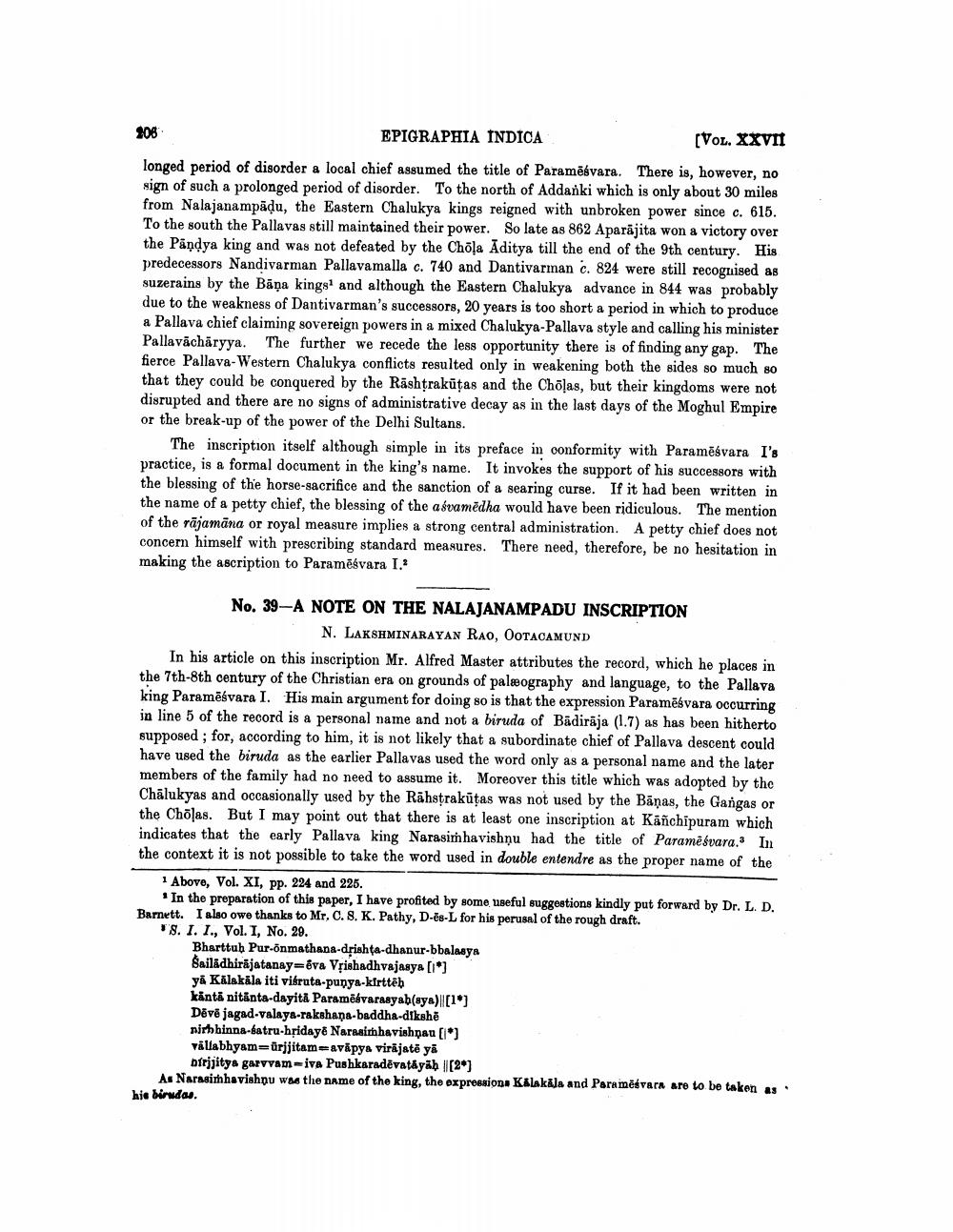________________
EPIGRAPHIA INDICA
[VOL. XXVII longed period of disorder a local chief assumed the title of Parameśvara. There is, however, no sign of such a prolonged period of disorder. To the north of Addanki which is only about 30 miles from Nalajanampaḍu, the Eastern Chalukya kings reigned with unbroken power since c. 615. To the south the Pallavas still maintained their power. So late as 862 Aparajita won a victory over the Pandya king and was not defeated by the Chōla Aditya till the end of the 9th century. His predecessors Nandivarman Pallavamalla c. 740 and Dantivarman c. 824 were still recognised as suzerains by the Bana kings and although the Eastern Chalukya advance in 844 was probably due to the weakness of Dantivarman's successors, 20 years is too short a period in which to produce a Pallava chief claiming sovereign powers in a mixed Chalukya-Pallava style and calling his minister Pallavacharyya. The further we recede the less opportunity there is of finding any gap. The fierce Pallava-Western Chalukya conflicts resulted only in weakening both the sides so much so that they could be conquered by the Rashtrakutas and the Chōlas, but their kingdoms were not disrupted and there are no signs of administrative decay as in the last days of the Moghul Empire or the break-up of the power of the Delhi Sultans.
206
The inscription itself although simple in its preface in conformity with Parameśvara I's practice, is a formal document in the king's name. It invokes the support of his successors with the blessing of the horse-sacrifice and the sanction of a searing curse. If it had been written in the name of a petty chief, the blessing of the aśvamedha would have been ridiculous. The mention of the rājamāna or royal measure implies a strong central administration. A petty chief does not concern himself with prescribing standard measures. There need, therefore, be no hesitation in making the ascription to Paramesvara I.*
No. 39-A NOTE ON THE NALAJANAMPADU INSCRIPTION
N. LAKSHMINARAYAN RAO, OOTACAMUND
In his article on this inscription Mr. Alfred Master attributes the record, which he places in the 7th-8th century of the Christian era on grounds of palæography and language, to the Pallava king Paramesvara I. His main argument for doing so is that the expression Paramesvara occurring in line 5 of the record is a personal name and not a biruda of Badiraja (1.7) as has been hitherto supposed; for, according to him, it is not likely that a subordinate chief of Pallava descent could have used the biruda as the earlier Pallavas used the word only as a personal name and the later members of the family had no need to assume it. Moreover this title which was adopted by the Chalukyas and occasionally used by the Rahsṭrakūtas was not used by the Baņas, the Gangas or the Chōlas. But I may point out that there is at least one inscription at Kanchipuram which indicates that the early Pallava king Narasimhavishnu had the title of Paramesvara. In the context it is not possible to take the word used in double entendre as the proper name of the
1 Above, Vol. XI, pp. 224 and 225.
In the preparation of this paper, I have profited by some useful suggestions kindly put forward by Dr. L. D. Barnett. I also owe thanks to Mr. C. S. K. Pathy, D-es-L for his perusal of the rough draft.
S. I. I., Vol. I, No. 29.
Bharttub Pur-onmathana-drishta-dhanur-bbalasya Sailädhirajatanay-éva Vrishadhvajasya [*]
ya Kalakala iti viśruta-punya-kirtteh käntä nitänta-dayitä Parameévarasyab(sya)||[1*] Děvě jagad-valaya-rakshana-baddha-dikshë
nirbhinna-éatru-hridayê Narasimhavishnau [*] vallabhyam ürjjitam-aväpya virajatē yā nirjjitys garvvam-iva Pushkaradevatāyāḥ ||[2*]
As Narasimhavishnu was the name of the king, the expressions Kalakala and Paramesvara are to be taken as hie birudas.




